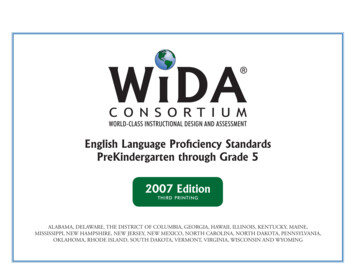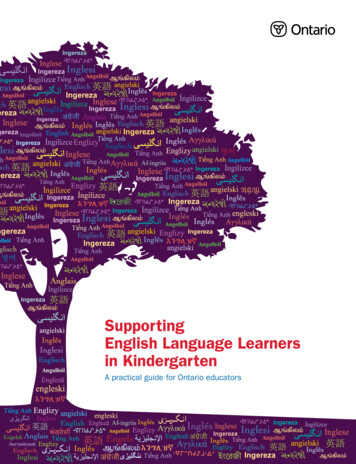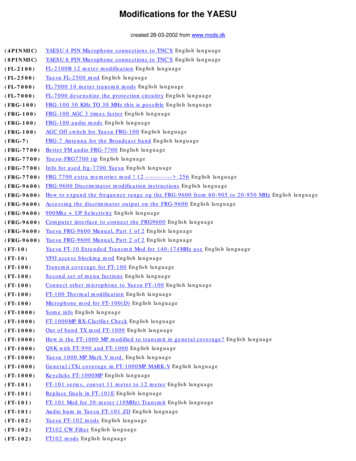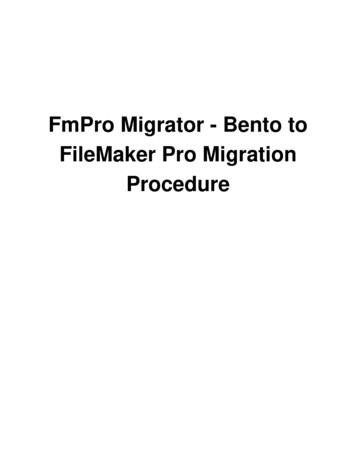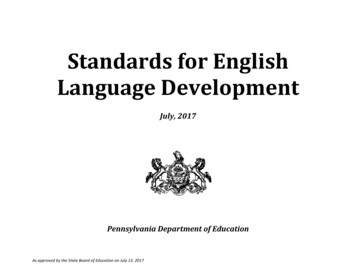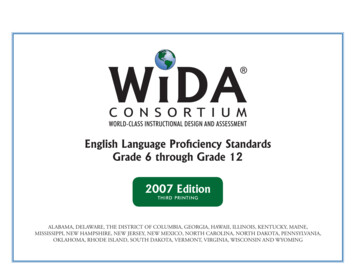
Transcription
WORLD-CLASS INSTRUCTIONAL DESIGN AND ASSESSMENTEnglish Language Proficiency StandardsGrade 6 through Grade 122007 EditionTHIRD PRINTINGALABAMA, DELAWARE, THE DISTRICT OF COLUMBIA, GEORGIA, HAWAII, ILLINOIS, KENTUCKY, MAINE,MISSISSIPPI, NEW HAMPSHIRE, NEW JERSEY, NEW MEXICO, NORTH CAROLINA, NORTH DAKOTA, PENNSYLVANIA,OKLAHOMA, RHODE ISLAND, SOUTH DAKOTA, VERMONT, VIRGINIA, WISCONSIN AND WYOMING
Copyright NoticeThe WIDA English Language Proficiency Standards, 2007 Edition, PreKindergarten through Grade 12 (“WIDA ELP Standards”) are owned bythe Board of Regents of the University of Wisconsin System on behalf of the WIDA Consortium. The WIDA ELP Standards are protectedby United States copyright laws and may not be reproduced, modified, or distributed without the prior written permission of WCER andthe Board of Regents of the University of Wisconsin System. The WIDA ELP Standards are for your personal, noncommercial use only. Youmay not alter or remove any trademark, copyright or other notice from copies of this booklet.Fair use of the WIDA ELP Standards includes reproduction for the purpose of teaching (including multiple copies for lesson planning). Ifyou are not sure whether your use of this booklet and the WIDA ELP Standards falls within fair use or if you want permission to use thecopyrighted WIDA ELP Standards for purposes other than personal or fair use, please contact the WIDA Consortium intellectual propertymanager, Jim Lyne, at jwlyne@wisc.edu or (608) 265-2262. 2007 Board of Regents of the University of Wisconsin System, on behalf of the WIDA Consortium—www.wida.us.Second printing, 2008Third printing, 2009
About the WIDA English Language ProficiencyStandardsdevelopment. Overall, the standards center on the languageneeded and used by ELLs to succeed in school.WIDA’s English Language Proficiency Standards for EnglishLanguage Learners in Pre-Kindergarten through Grade 12:Frameworks for Formative and Summative Assessment andInstruction, 2007 edition, is a key component of the World-ClassInstructional Design and Assessment (WIDA) Consortium’sassessment system. WIDA’s vision of language proficiencyencompasses both social and academic contexts tied to schooling,particularly to standards, curriculum, and instruction. Bydeveloping these English language proficiency (ELP) standards,first published in 2004, the WIDA Consortium has respondedto this emergent vision to link language learning withacademic content. Furthermore, these ELP standards guide thedevelopment of test blueprints, task specifications, and ELPmeasures, primarily WIDA’s ACCESS for ELLs test.Each standard is organized by grade level cluster (PreK-K, grades1-2, grades 3-5, grades 6-8, and grades 9-12) and by languagedomain (listening, speaking, reading, and writing). Within eachgrade cluster and domain, there are five model performanceindicators (MPIs), one for each language proficiency level from 1,Entering, to 5, Bridging. All five MPIs focus on the same exampletopic from a content area reflected in the standard, forming a“strand” that illustrates the language development continuum.Each MPI contains three elements: a language function (e.g.,describe, justify), an example topic (e.g., weather, humanpopulations), and a form of support through level 4 (e.g., picturesor illustrations, working in small groups). The components ofthe ELP standards, from frameworks down to the elementsof an MPI, work together to form the standards document, acritical tool for educators of ELLs for curriculum development,instruction and assessment.Originally developed by consortium members with funding froma U.S. Department of Education Enhanced Assessment Grant,the standards are designed for the many audiences in the field ofeducation who are impacted by English language learners (ELLs).This second edition reflects an evolving understanding of theneeds of ELLs and their educators in the use of the ELP standardsas an instructional and assessment tool.Organization of the StandardsThere are five WIDA ELP Standards, which appear in twoframeworks: Summative (the outcomes of learning) andFormative (the processes of learning). The standards, identical forboth frameworks, reflect the social and academic dimensions ofacquiring a second language that are expected of ELLs in gradelevels PreK-12 attending schools in the United States. EachELP standard addresses a specific context for English languageThe WIDA English Language Proficiency Standards English Language Proficiency Standard 1: English language learnerscommunicate for Social and Instructional purposes within theschool setting. English Language Proficiency Standard 2: English language learnerscommunicate information, ideas, and concepts necessary foracademic success in the content area of Language Arts. English Language Proficiency Standard 3: English language learnerscommunicate information, ideas, and concepts necessary foracademic success in the content area of Mathematics. English Language Proficiency Standard 4: English language learnerscommunicate information, ideas, and concepts necessary foracademic success in the content area of Science. English Language Proficiency Standard 5: English language learnerscommunicate information, ideas, and concepts necessary foracademic success in the content area of Social Studies.Introductioni
IntroductionThe ELP standards are often abbreviated as Social andInstructional language, the language of Language Arts, thelanguage of Mathematics, the language of Science, and thelanguage of Social Studies.The Language Proficiency Levels and PerformanceDefinitionsThe five language proficiency levels outline the progression oflanguage development implied in the acquisition of English as anadditional language, from 1, Entering the process, to 6, Reachingthe attainment of English language proficiency. The languageproficiency levels delineate expected performance and describewhat ELLs can do within each domain of the standards. ThePerformance Definitions define the expectations of students ateach proficiency level. The definitions encompass three criteria:linguistic complexity—the amount and quality of speech orwriting for a given situation; vocabulary usage—the specificity ofwords or phrases for a given context; and language control—thecomprehensibility of the communication based on the amountand types of errors.The Performance Definitions (see page 3) are a key componentof the standards documents, and the use of the standardsand corresponding MPIs must be in conjunction with thePerformance Definitions. The MPIs, delineated by languageproficiency level, give expectations for what students shouldbe able to process and produce at a given proficiency level. ThePerformance Definitions describe how well the student can orshould be expected to do so. For example, the language function“describe” appears in MPIs at levels 1-4. What language doesa student at language proficiency level 2 need to produce inorder to “describe”? What can he or she reasonably be expectedto process to understand a description? How does this comparewith a student at language proficiency level 4? The languagefunction “describe” for a level 2 student may mean producingor comprehending phrases or short sentences using commonadjectives and modifiers, whereas a level 4 student may beexpected to process or use extended discourse incorporatingrelative clauses, similes or metaphors. This example illustrates howthe Performance Definitions are an essential companion to thestrands of MPIs.ii
Performance Definitions for the levels of English language proficiencyAt the given level of English language proficiency, English language learners will process, understand, produce, or use:6Reaching 5Bridging specialized or technical language reflective of the content area at grade levela variety of sentence lengths of varying linguistic complexity in extended oral or written discourse as required by the specifiedgrade leveloral or written communication in English comparable to proficient English peersthe technical language of the content areas;a variety of sentence lengths of varying linguistic complexity in extended oral or written discourse, including stories, essays,or reports;oral or written language approaching comparability to that of English proficient peers when presented with grade levelmaterial4Expanding specific and some technical language of the content areas;a variety of sentence lengths of varying linguistic complexity in oral discourse or multiple, related paragraphs;oral or written language with minimal phonological, syntactic, or semantic errors that do not impede the overall meaning ofthe communication when presented with oral or written connected discourse with occasional visual and graphic support3Developing general and some specific language of the content areas;expanded sentences in oral interaction or written paragraphs;oral or written language with phonological, syntactic, or semantic errors that may impede the communication but retainmuch of its meaning when presented with oral or written, narrative or expository descriptions with occasional visual andgraphic support2Beginning general language related to the content areas;phrases or short sentences;oral or written language with phonological, syntactic, or semantic errors that often impede the meaning of thecommunication when presented with one to multiple-step commands, directions, questions, or a series of statements withvisual and graphic support1Entering pictorial or graphic representation of the language of the content areas;words, phrases, or chunks of language when presented with one-step commands, directions,WH-questions, or statements with visual and graphic supportIntroductioniii
Example Topics and Genres: Content Related toWIDA’s English Language Proficiency StandardsThese examples, representative of state academic content standards, provide context for the English language development described in the strands of Model Performance Indicators.Standard 1:Social andInstructional languageStandard 2:The language ofLanguage ArtsExample TopicsExample Genres Adventures Assignments/Research Character development Ballads Editorials Instructions/ Historical documentsAssignments Human interest Resources & supplies Mythology School behavior Poetry/Free verse School life Science fiction Social interaction Technical texts Use of informationExample Topics Use of multiple Alliterationresources Author’s purpose Use of register Biographies Comprehension strategies Dialogue Editing Figures of speech Literacy devices Metaphors & similes Multimedia Multiple meanings Personification Synonyms & antonyms Test-taking strategies Word originsGrades 6-8Standard 3:The language ofMathematicsExample Topics Algebraic equations Area, volume &circumference Complex two- & threedimensional figures Data interpretation &statistics Data sets & plots Decimals Estimation Factors Fractions Geometric relations Integers Line segments & angles Measures of centraltendency (mean, median,mode, range) Metric & standard unitsof measurement Parallel lines Percent Perimeter Probability Ratio & proportion Square rootStandard 4:The language of ScienceExample Topics Atoms & molecules Bacteria to plants Body systems & organs Chemical building blocks Climate/Temperature change Climate zones Comets & meteorites Cycles Elements & compounds Forms of energy Light Motion & force Natural disasters Populations, resources &environments Processes Reproduction Scientific inventions ordiscoveries Scientific tools or instruments Solar system Sound Universe: Stars and planets WaterStandard 5:The language ofSocial StudiesExample Topics Agriculture America’s story Ancient/Medieval civilizations Bill of Rights Civic rights & responsibilities Civil wars Colonization Countries & continents Cultural perspectives & framesof reference Economic trends Forms & organization ofgovernment Freedom & democracy Human resources Longitude/Latitude/Time zones Maps Revolution Slavery U.S. Constitution41
Grades 6-842ELP Standard 1: Social and Instructional Language, Formative FrameworkREADINGWRITINGLevel 1EnteringLevel 2BeginningLevel 3DevelopingLevel 4ExpandingLevel 5BridgingCharacterdevelopmentPoint out schoolbehavior from gesturesor illustrations andoral statements with apartner (e.g., in class, onthe playground, in gymclass, on the bus)Identify examplesof school etiquettebased on gestures orillustrations and oraldescriptions with apartner (e.g., turntaking)Interact in socialand cultural schoolsituations to depictcharacter developmentbased on oraldescriptions in smallgroups (e.g., in thelunchroom)Role play schoolsituations involvingcharacter developmentbased on oraldescriptions insmall groups (e.g.,succumbing to peerpressure)Interpret oral scenariosor readings oncharacter developmentthrough role play ordramatizationSocialinteractionRespond to and offergreetings, compliments,introductions orfarewells with teachersor peers in L1 and L2Ask questions orexchange informationwith teachers or peers inL1 and L2Initiate or engage inconversation with peersor in small groupsInitiate, respond toor clarify meaning ofidiomatic expressions,slang or nuances inconversation with peersExpress or respond tohumor or sarcasm inconversationUse of multipleresourcesSearch for topics onWeb sites, in libraries orusing other sources witha partner from a listClassify topics identifiedon Web sites or othersources (e.g., classgenerated list) with apartnerSort informationon topics of choicegathered from multiplesources with a partnerArrange informationon topics of choicegathered from multiplesources in logical orderwith a partnerConfirm or rearrangeinformation afterre/reading of topics ofchoice gathered frommultiple sourcesUse of registerRespond to requests orinvitations supportedvisually using words andpolite phrasesRespond to or initiatecorrespondence (e.g.,e-mail, messages,postcards or notes) tofriends or siblings usinginformal registerRespond to or generatetext (e.g., suggestions,announcements, journalentries, complaints,apologies or thankyous) within the schoolcontext using semiformal registerRespond to teachers(e.g., feedback fromjournals) or completeassignments usingformal registerProduce a variety ofwriting forms usingregister appropriate toaudienceLevel 6- ReachingSPEAKINGLISTENINGExampleTopics
READINGWRITINGLevel 1EnteringLevel 2BeginningLevel 3DevelopingLevel 4ExpandingLevel 5BridgingResources &suppliesIdentify neededresources or supplies foractivities from picturesand oral statements(e.g., “pencils,” “paper,”“computers”)Match needed resourcesor supplies with types ofactivities from picturesand oral statements(e.g., calculators andmath books)Categorize neededresources or supplieswith types of activitiesfrom pictures and oraldescriptionsAnalyze tasks or projectsby activities and matchwith needed resourcesbased on pictures andoral discourseEvaluate and selectneeded resources fortasks or projects basedon oral discourseInstructions/AssignmentsRespond to WHquestions or commandsbased on oralinstructions or visuallysupported assignmentsParaphrase or retelloral instructions orvisually supportedassignments (e.g., recapof homework)Recount steps forfollowing oralinstructions or visuallysupported assignments(e.g., through thinkalouds)Summarize oralinstructions or visuallysupported assignmentsExplain, with details,reasons for instructionsor assignmentsappropriate for gradelevelUse ofinformationLocate words or phraseson socially-related topics(e.g., school dances)from visually supportedinformation (e.g., onposters)Identify sentence-levelinformation on sociallyrelated topics fromillustrated text (e.g.,in advertisements orinstructions)Summarize informationon socially-relatedtopics from illustratedparagraphsInterpret informationon socially-relatedtopics from illustratedtext (e.g., directions forboard or video games)Infer information onsocially-related topicsfrom textSchool lifeMake lists associatedwith school life fromvisuals and word/phrasebanks (e.g., subjects,classes, activities)Outline or completegraphic organizers aboutschool life (e.g., weeklyschedule with times andsubjects)Discuss different aspectsof school life usinggraphic organizers(e.g., likes and dislikes,favorite subjects on Tchart)Suggest ideas formaking changesto school life (e.g.,rearranging schedulesor adding clubs) usinggraphic organizersPropose changes toschool life and givereasons for choices (e.g.,policies or procedures)Level 6- ReachingSPEAKINGLISTENINGExampleTopicsELP Standard 1: Social and Instructional Language, Summative FrameworkGrades 6-843
Grades 6-844ELP Standard 2: The Language of Language Arts, Formative FrameworkLevel 1EnteringExample GenreLISTENINGPoetry/FreeverseExample TopicExample GenreSPEAKINGHuman interestExample TopicMultimediaLevel 3DevelopingLevel 4ExpandingLevel 5BridgingIdentify illustratedrhyming words inrecited excerpts ofpoems and check with apartnerClassify illustrationsdescriptive of recitedexcerpts as poetry orfree verse and checkwith a partnerMatch main ideas inrecited short poemsor free verse withillustrations and checkwith a partnerInterpret main ideasor details in recitedpoems or free verse withillustrations and checkwith a partnerMake inferences frommain ideas and detailsof recited grade-levelpoetry or free verseMatch oral commandswith learning strategiesrepresented visually andcompare with a partner(e.g., “Fill in bubbles onanswer sheets.”)Follow oral directionsassociated with learningstrategies representedvisually and comparewith a partnerUse learning strategiesaccording to oraldirections and comparewith a partner (e.g.,“Answer easy questionsfirst on tests.”)Practice using learningstrategies describedorally in a variety offamiliar situations andverify with a partnerApply learning strategiesdescribed orally to newsituationsDescribe persons orobjects in humaninterest stories (e.g.,“Girls talking”) fromvisual frames or mediaexcerptsRelate main ideas ofhuman interest storiesfrom visual frames ormedia excerpts (e.g.,news broadcasts)State reasons for the‘interest’ in humaninterest stories fromvisual frames or mediaexcerptsApply ideas fromhuman interest storiesfrom visual framesor media excerpts topersonal experiencesDefend and justifystances or points ofview in human intereststories from varioussourcesAnswer choice or yes/no questions regardingvisually supportedinformation frommultimedia (e.g., onads, cartoons, signs orposters)Restate or paraphrasevisually supportedinformation frommultimedia (e.g., innewspapers, magazinesor broadcasts)Present visuallysupported informationfrom multimedia (e.g.,in Web sites, CDs orsoftware)Summarize or integratevisually supportedinformation frommultimedia (e.g., intrade books, books ontape or videos)Give reviews ofinformation frommultimedia that includeinterpretations, critiquesor self-reflectionsLevel 6- iesLevel 2Beginning
Level 1EnteringExample GenreREADINGAdventuresExample TopicGenresWRITINGEditorialsExample TopicEditingLevel 3DevelopingLevel 4ExpandingLevel 5BridgingIdentify words orphrases associated withadventures using visualsupport and word/phrase walls or banksAnswer WH- questionsrelated to adventuresusing visual support(e.g., “Who ismissing?”) and sharewith a peerSequence plots ofadventures using visualsupport and share witha peerSummarize plots ofadventures using visualsupport and share witha peerIdentify cause and effectof events on charactersin adventure storiesIdentify words orphrases supported byillustrations associatedwith various genres(e.g., adventures,ballads, science fiction,mythology)Match generalvocabulary orexpressions in contextwith illustrationsassociated with variousgenres read orallyAssociate types of genreswith language structuresor specific vocabulary inillustrated text or oraldescriptionPair illustratedsummaries with excerptsfrom genres read orallyor in writing (e.g.,mythology, sciencefiction or ballads)Infer types ofgenres from writtendescriptions orsummaries in gradelevel textAnswer yes/no or choicequestions to agree ordisagree with currentissues discussed withpartners or in smallgroups in L1 or L2React positively ornegatively to currentissues in editorialsdiscussed in smallgroups in L1 or L2Give opinions inreaction to currentissues in editorials (e.g.,from newspapers orWeb sites) discussed insmall groupsDiscuss pros and consof current issues ineditorials in smallgroupsProduce editorials(opinions backed byevidence) in response tonewspaper or Web sitearticlesBrainstorm words orphrases relevant totasks with a partner(e.g., using bilingual orpicture dictionaries) inL1 or L2Check some aspectof editing (e.g.,conventions ormechanics) withresources (e.g.,computers, peers orvisual models) andconfirm with a partnerin L1 or L2Engage in peer editing(e.g., using checklists)during process writingand make notations to apartner in L1 or L2Self-edit duringprocess writing usingmultiple resources(e.g., thesauruses ordictionaries) and checkwith a partnerSelf-assess processwriting using rubricsor other resources andexplain editing strategiesLevel 6- ReachingExample GenreLevel 2BeginningELP Standard 2: The Language of Language Arts, Formative FrameworkGrades 6-845
Grades 6-846ELP Standard 2: The Language of Language Arts, Summative FrameworkLevel 1EnteringExample GenreLISTENINGPoetry/Free verseExample TopicLiterary devicesSPEAKINGHuman interestExample TopicBiographiesLevel 3DevelopingLevel 4ExpandingLevel 5BridgingIdentify illustratedrhyming words inrecited excerpts frompoemsClassify illustrationsdescriptive of recitedexcerpts of poetry orfree verseMatch main ideas inrecited short poemsor free verse withillustrationsInterpret main ideasor details in recitedpoems or free verse withillustrationsMake inferences frommain ideas and detailsof recited grade-levelpoetry or free verseIdentify words andphrases related todifferent time framesfollowing oral directionswith visual supportMatch oral phrases orsentences supportedvisually with differenttime framesIdentify use of literarydevices related todifferent time framesin visually supporteddiscourse (e.g.,foreshadowing orflashback)Analyze use of literarydevices related todifferent time frames invisually supported oralpassagesInterpret use of literarydevices related todifferent time framespresented orally fromgrade-level textDescribe persons orobjects in humaninterest stories fromvisual framesRelate main ideas ofhuman interest storiesfrom visual framesState reasons for the‘interest’ in humaninterest stories fromvisual framesApply ideas fromhuman interest storiesfrom visual framesDefend and justifystances or points ofview in human intereststoriesAnswer WH- questionsfrom pictures orcartoons related tobiographiesDescribe pictures orcartoons related tobiographiesState biographicalinformation basedon timelines or othergraphic organizersSummarize pointsfrom outlines orgraphic organizers onbiographiesProject character rolesusing notes on gradelevel biographiesLevel 6- ReachingExample GenreLevel 2Beginning
Level 1EnteringExample GenreREADINGAdventuresExample TopicExample GenreWRITINGEditorialsExample TopicSynonyms &antonymsLevel 3DevelopingLevel 4ExpandingLevel 5BridgingIdentify words orphrases associated withadventures using visualsupportAnswer WH- questionsrelated to adventuresusing visual support(e.g., “What is the spylooking for?”)Sequence plots ofadventures using visualsupportSummarize plots ofadventures using visualsupportPredict effects ofaltering events inadventures (e.g., “If Xhappened at anothertime, what do you thinkwould change?”)Respond to literalquestions that involvefigures of speech fromvisually supportedphrasesIdentify words orphrases representingfigures of speech invisually supportedrelated sentences (e.g.,like or as)Categorize or classifyfigures of speech invisually supportedpassagesIdentify figures ofspeech in visuallysupported text andmatch to their meaningsInterpret figures ofspeech in grade-leveltextAnswer questions toagree or disagree withcurrent issues frommodels depicted visuallyor graphicallyReact positively ornegatively to currentissues in editorials frommodels depicted visuallyor graphicallyGive opinions inreaction to currentissues in editorials frommodels depicted visuallyor graphically (e.g., “Ithink ”)Discuss pros and consof current issues ineditorials from modelsdepicted visually orgraphically (e.g., “Iagree with X; I disagreewith Y.”)Produce editorials(opinions backed byexamples) from currentgrade-level issuesMatch familiar symbols,words or phrases withantonyms from word/phrase banks and visualsDescribe familiarpeople, places or eventsin phrases or sentenceswith synonyms orantonyms using word/phrase banks and visualsRewrite visuallysupported paragraphsusing synonyms orantonyms to changecontext or purpose ofcommunication (e.g.,switch positive withnegative traits)Produce originalideas that incorporatesynonyms or antonymsfrom visually supportedmaterialCreate stories or essaysthat include synonymsor antonymsLevel 6- ReachingFiguresof speech(metaphors,personification,similes)Level 2BeginningELP Standard 2: The Language of Language Arts, Summative FrameworkGrades 6-847
Grades 6-848Level 1EnteringLevel 2BeginningMeasuresof centraltendency(mean, median,mode & range)Match oral languageassociated withmeasures of centraltendency with visual orgraphic displaysIllustrate or identifyexamples of measuresof central tendencybased on oral directionsand visual or graphicdisplaysSelect measures ofcentral tendency basedon visual or graphicdisplays and oraldescriptions of real-lifesituationsMake predictions orestimates of measures ofcentral tendency fromoral scenarios and visualor graphic displaysMake inferences aboutuses of measures ofcentral tendency fromoral scenarios of gradelevel materialsMetric &standard unitsof measurementName tools and unitsof standard or metricmeasurement fromlabeled examples (e.g.,ruler—inches or cm;scale—pounds or kilos)Estimate standard ormetric measurementfrom pictures or realobjects (e.g., “Thedog weighs about 10kilograms.”)Describe real-lifesituations wheremeasurement is neededfrom illustrated scenes(e.g., at the clinic ormarketplace)Discuss howmeasurement is usedin real-life situationsfrom illustrated scenes(e.g., construction,architecture orcartography)Explain how or whento convert standard ormetric measurement inreal-life situations (e.g.,recipes or temperatures)Percent/DecimalsIdentify or sort valuesnoted on everydayproducts related topercent or decimals(e.g., nutritional facts,serving sizes or % dailyuse) with a partnerCompare or rankorder values notedon everyday productsrelated to percent ordecimals with a partnerFollow listedinstructions that involvehands-on math usingpercent or decimals(e.g., from recipes orgames) with a partnerFollow writteninstructions todetermine when andhow to apply mathin real-life situationsinvolving percent ordecimals (e.g., sales tax,interest rates or tips)with a partnerInterpret variousrepresentations ofnumbers in real-lifeproblems involvingpercent or decimalsfrom various textsProbabilityRecord and labeloutcomes of eventsinvolving chance usingreal objects (e.g., coinflips)Give outcomes of eventsinvolving probabilityusing real objects withwords and phrases orshort sentencesPropose probabilitybased on observedoutcomes and describeresults in a series ofsentencesDetail possiblecombinations based onprobability and compareagainst observedoutcomes in paragraphformExplain and give reasonsfor likely probabilities inmultiple paragraphsWRITINGREADINGExampleTopicsLevel 3DevelopingLevel 4ExpandingLevel 5BridgingLevel 6- ReachingSPEAKINGLISTENINGELP Standard 3: The Language of Mathematics, Formative Framework
ExampleTopicsLevel 3DevelopingLevel 4ExpandingLevel 5BridgingPercent/FractionsIdentify proportionalrepresentation of objectsfrom oral directionsand graphs or visuals(e.g., “Two halves makea whole. Find half apizza.”)Follow multi-steporal directions tochange proportionalrepresentation ofpercent or fractions ingraphs or visualsMatch everydayexamples of percentor fractions with oraldescriptions usinggraphic or visualsupport (e.g., interest ortaxes)Analyze everydaysituations involvingpercent or fractionsfrom oral scenarioswith graphic or visualsupport (e.g., “Salestax is based on percent.When might you needto use percent?”)Apply ways of usingpercent or fractions ingrade-level situationsfrom oral discourseLine segments& anglesIdentify line segmentsor angles from picturesof everyday objectsDefine or describe typesof line segments orangles from pictures ofeveryday objects (e.g.,“This angle is larger.”)Compare/contrast typesof line segments fromdiagrams (e.g., parallelv. perpendicular lines)Discuss how to solveproblems using differenttypes of line segmentsor angles from diagramsExplain, with details,ways to solve grade-levelproblems using differenttypes of line segmentsor anglesPerimeter/Area, volume &circumferenceMatch vocabularyassociated withperimeter or area withgraphics, symbols orfiguresIdentify visuallysupported examplesof use of perimeter,area, volume orcircumference in realworld situations (e.g.,painting a room)Classify visuallysupported examplesof use of perimeter,area, volume orcircumference in realworld situationsOrder steps forcomputing perimeter,area, volume orcircumference in realworld situations usingsequential languageSelect reasons for uses ofperimeter, area, volumeor circumference ingrade-level textAlgebraicequationsShow pictorialrepresentations orlabel terms related toalgebraic equations frommodels or visualsGive examples andexpress meaningof terms related toalgebraic equations frommodels or visualsDescribe mathoperations, procedures,patterns or functionsinvolving algebraicequations from modelsor visualsProduce everyday mathproblems involvingalgebraic equations andgive steps in problemsolving from models orvisualsSummarize or predictinformation neededto solve problems
populations), and a form of support through level 4 (e.g., pictures or illustrations, working in small groups). Th e components of the ELP standards, from frameworks down to the elements of an MPI, work together to form the standards document, a critical tool for educators of ELLs for curriculum development, instruction and assessment.
